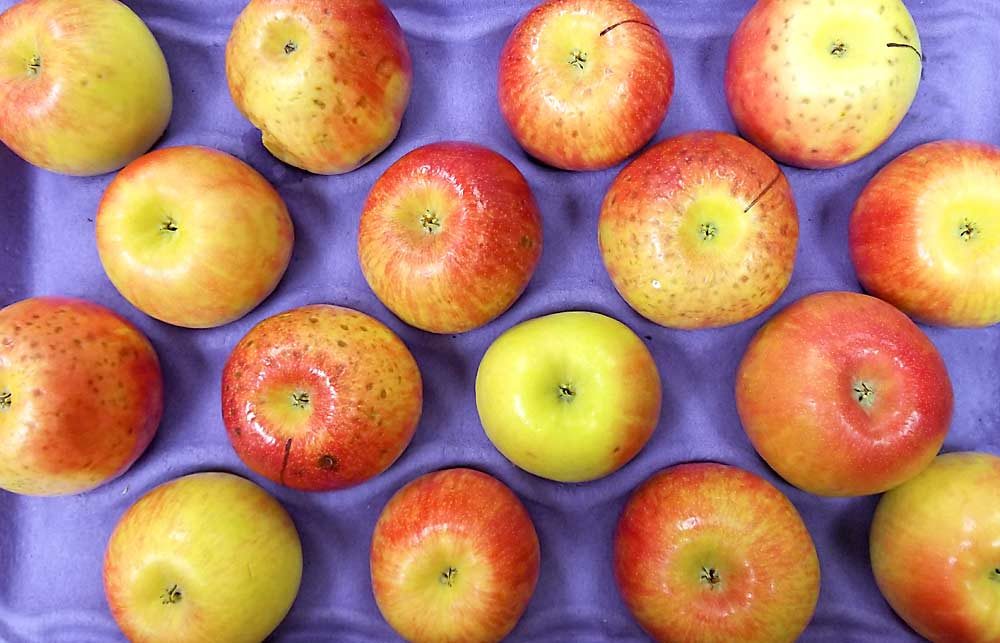Bitter pit is a “terrible scourge,” not only for growers in New York’s Hudson Valley but throughout the entire state, because it cuts into packouts of the state’s most profitable apple, Honeycrisp, said Dan Donahue, a tree fruit specialist with Cornell Cooperative Extension’s Eastern New York Commercial Horticulture Program.
Donahue spoke during the Washington State Tree Fruit Association’s Annual Meeting in Wenatchee in December. He told his Pacific Northwest audience what researchers have learned, and still have to learn, about bitter pit suppression in New York.
Donahue and Cornell colleagues decided to study early season development of bitter pit in Honeycrisp to create recommendations growers can use to reduce packout losses, although questions remain about how and why the recommendations reduce development of the difficult-to-predict disorder. The study was conducted with financial help from the New York State Apple Research and Development Program.
After gathering three years of data so far, they’ve concluded that the plant growth regulator Apogee can suppress bitter pit — but timing is everything. Apogee (prohexadione calcium) applied at pink stage can suppress bitter pit by about 50 percent. Apogee sprayed at conventional timings, however, made bitter pit worse in two of the study’s three years.

“That was completely unexpected,” he said. “We have no reasonable explanation.”
Donahue said bitter pit is commonly considered a calcium deficiency, but it is better described as a calcium-related disorder whose symptoms result from the breakdown of cells in distinct groups. The calcium deficiency is localized, with damage expressing as distinct lesions, not a broad breakdown as seen in storage disorders such as soft scald, he said.
“The questions of why calcium was deficient in a particular apple, why a specific grouping of cells desiccates, and at what time in that fruit’s development those cells became deficient are not well understood,” Donahue said.
Episodes of bitter pit can vary greatly — not only from year to year but from block to block, tree to tree and apple to apple. That makes it harder to predict. Variability is a “huge” problem in Honeycrisp, he said.
“You can’t tell by looking at fruit on the tree at harvest, you can’t tell by what’s in the bin, you can’t tell from the packing line,” Donahue said. “You have to properly sample the tree, put the fruit away for 60 days, then take a look at it to get an idea what the actual bitter pit level was.”
Apogee potential
Starting in 2016, Donahue and his team sprayed Apogee in several trials conducted in commercial Honeycrisp blocks in eastern New York. They applied it using “industry standard” timings: early petal fall, three weeks later, then three weeks after that. They also applied it at pink stage.
Early on, Donahue hypothesized that competition for calcium between shoots and fruitlets contributed to the incidence of bitter pit, and that reducing shoot growth early in the season might channel more calcium into the fruit. Data from the study did not support that idea, however. Apogee suppresses bitter pit but does not increase measurable calcium in either leaves or fruit, he said.
“Apogee at pink was effective at bitter pit suppression, but not for the reason we thought,” Donahue said. “We’re seeing something that works, but we don’t know why it works.”

Spraying Apogee at pink stage in apples is now legal in New York state. After that timing became legal in spring 2018, 71 percent of growers in the Hudson Valley started using it, he said.
Donahue’s advice for Honeycrisp growers is to apply Apogee at pink (6 ounces per acre in a tall spindle system), and avoid it at conventional timings (unless you’re battling serious fire blight or extreme vegetative growth). He also advised planting Honeycrisp on Budagovsky 9 rootstock.
“B.9 is flat-out superior when it comes to bitter pit suppression,” he said. “Others think it’s a dog, but I think it’s a great rootstock for Honeycrisp if you grow it properly.”
Donahue also suggested applying foliar calcium sprays starting at petal fall (he recommended the calcium formulation called Poma). Making calcium more available during this critical early period in fruit development helps reduce bitter pit, he said.
With help from new funding provided by the New York Farm Viability Institute, the bitter pit study was expanded in 2019 to include all of New York state. Work will continue in 2020 with the goals of further refining recommendations and implementing preharvest bitter pit prediction by orchard block, Donahue said. •
—by Matt Milkovich
Related:
—Beating bitter pit in Honeycrisp






very interesting information